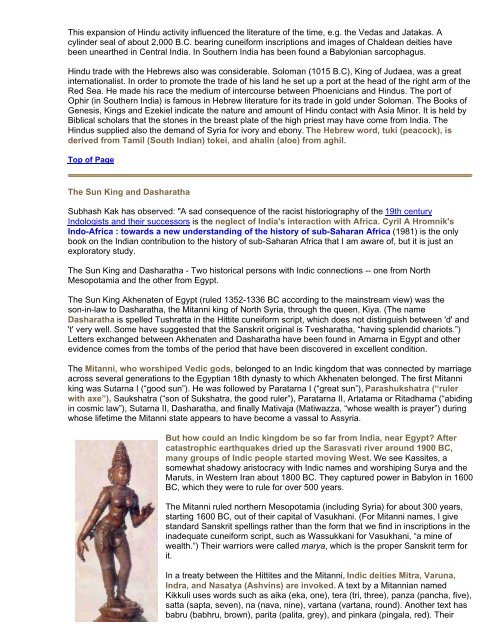A Tribute to Hinduism - India and Egypt - Mandhata Global
A Tribute to Hinduism - India and Egypt - Mandhata Global
A Tribute to Hinduism - India and Egypt - Mandhata Global
You also want an ePaper? Increase the reach of your titles
YUMPU automatically turns print PDFs into web optimized ePapers that Google loves.
This expansion of Hindu activity influenced the literature of the time, e.g. the Vedas <strong>and</strong> Jatakas. A<br />
cylinder seal of about 2,000 B.C. bearing cuneiform inscriptions <strong>and</strong> images of Chaldean deities have<br />
been unearthed in Central <strong>India</strong>. In Southern <strong>India</strong> has been found a Babylonian sarcophagus.<br />
Hindu trade with the Hebrews also was considerable. Soloman (1015 B.C), King of Judaea, was a great<br />
internationalist. In order <strong>to</strong> promote the trade of his l<strong>and</strong> he set up a port at the head of the right arm of the<br />
Red Sea. He made his race the medium of intercourse between Phoenicians <strong>and</strong> Hindus. The port of<br />
Ophir (in Southern <strong>India</strong>) is famous in Hebrew literature for its trade in gold under Soloman. The Books of<br />
Genesis, Kings <strong>and</strong> Ezekiel indicate the nature <strong>and</strong> amount of Hindu contact with Asia Minor. It is held by<br />
Biblical scholars that the s<strong>to</strong>nes in the breast plate of the high priest may have come from <strong>India</strong>. The<br />
Hindus supplied also the dem<strong>and</strong> of Syria for ivory <strong>and</strong> ebony. The Hebrew word, tuki (peacock), is<br />
derived from Tamil (South <strong>India</strong>n) <strong>to</strong>kei, <strong>and</strong> ahalin (aloe) from aghil.<br />
Top of Page<br />
The Sun King <strong>and</strong> Dasharatha<br />
Subhash Kak has observed: "A sad consequence of the racist his<strong>to</strong>riography of the 19th century<br />
Indologists <strong>and</strong> their successors is the neglect of <strong>India</strong>'s interaction with Africa. Cyril A Hromnik's<br />
Indo-Africa : <strong>to</strong>wards a new underst<strong>and</strong>ing of the his<strong>to</strong>ry of sub-Saharan Africa (1981) is the only<br />
book on the <strong>India</strong>n contribution <strong>to</strong> the his<strong>to</strong>ry of sub-Saharan Africa that I am aware of, but it is just an<br />
explora<strong>to</strong>ry study.<br />
The Sun King <strong>and</strong> Dasharatha - Two his<strong>to</strong>rical persons with Indic connections -- one from North<br />
Mesopotamia <strong>and</strong> the other from <strong>Egypt</strong>.<br />
The Sun King Akhenaten of <strong>Egypt</strong> (ruled 1352-1336 BC according <strong>to</strong> the mainstream view) was the<br />
son-in-law <strong>to</strong> Dasharatha, the Mitanni king of North Syria, through the queen, Kiya. (The name<br />
Dasharatha is spelled Tushratta in the Hittite cuneiform script, which does not distinguish between 'd' <strong>and</strong><br />
't' very well. Some have suggested that the Sanskrit original is Tvesharatha, “having splendid chariots.”)<br />
Letters exchanged between Akhenaten <strong>and</strong> Dasharatha have been found in Amarna in <strong>Egypt</strong> <strong>and</strong> other<br />
evidence comes from the <strong>to</strong>mbs of the period that have been discovered in excellent condition.<br />
The Mitanni, who worshiped Vedic gods, belonged <strong>to</strong> an Indic kingdom that was connected by marriage<br />
across several generations <strong>to</strong> the <strong>Egypt</strong>ian 18th dynasty <strong>to</strong> which Akhenaten belonged. The first Mitanni<br />
king was Sutarna I (“good sun”). He was followed by Paratarna I (“great sun”), Parashukshatra (“ruler<br />
with axe”), Saukshatra (“son of Sukshatra, the good ruler”), Paratarna II, Artatama or Ritadhama (“abiding<br />
in cosmic law”), Sutarna II, Dasharatha, <strong>and</strong> finally Mativaja (Matiwazza, “whose wealth is prayer”) during<br />
whose lifetime the Mitanni state appears <strong>to</strong> have become a vassal <strong>to</strong> Assyria.<br />
But how could an Indic kingdom be so far from <strong>India</strong>, near <strong>Egypt</strong>? After<br />
catastrophic earthquakes dried up the Sarasvati river around 1900 BC,<br />
many groups of Indic people started moving West. We see Kassites, a<br />
somewhat shadowy aris<strong>to</strong>cracy with Indic names <strong>and</strong> worshiping Surya <strong>and</strong> the<br />
Maruts, in Western Iran about 1800 BC. They captured power in Babylon in 1600<br />
BC, which they were <strong>to</strong> rule for over 500 years.<br />
The Mitanni ruled northern Mesopotamia (including Syria) for about 300 years,<br />
starting 1600 BC, out of their capital of Vasukhani. (For Mitanni names, I give<br />
st<strong>and</strong>ard Sanskrit spellings rather than the form that we find in inscriptions in the<br />
inadequate cuneiform script, such as Wassukkani for Vasukhani, “a mine of<br />
wealth.”) Their warriors were called marya, which is the proper Sanskrit term for<br />
it.<br />
In a treaty between the Hittites <strong>and</strong> the Mitanni, Indic deities Mitra, Varuna,<br />
Indra, <strong>and</strong> Nasatya (Ashvins) are invoked. A text by a Mitannian named<br />
Kikkuli uses words such as aika (eka, one), tera (tri, three), panza (pancha, five),<br />
satta (sapta, seven), na (nava, nine), vartana (vartana, round). Another text has<br />
babru (babhru, brown), parita (palita, grey), <strong>and</strong> pinkara (pingala, red). Their

















